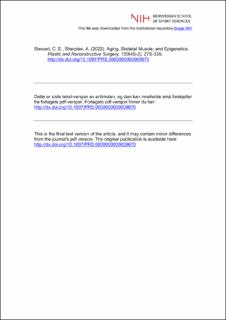| dc.contributor.author | Stewart, Claire E. | |
| dc.contributor.author | Sharples, Adam | |
| dc.date.accessioned | 2023-10-25T07:20:36Z | |
| dc.date.available | 2023-10-25T07:20:36Z | |
| dc.date.created | 2022-09-30T11:51:07Z | |
| dc.date.issued | 2022 | |
| dc.identifier.citation | Plastic and Reconstructive Surgery. 2022, 150(4S-2), 27S-33S. | en_US |
| dc.identifier.issn | 0032-1052 | |
| dc.identifier.uri | https://hdl.handle.net/11250/3098565 | |
| dc.description | I Brage finner du siste tekst-versjon av artikkelen, og den kan inneholde ubetydelige forskjeller fra forlagets pdf-versjon. Forlagets pdf-versjon finner du på journals.lww.com / In Brage you'll find the final text version of the article, and it may contain insignificant differences from the journal's pdf version. The definitive version is available at journals.lww.com | en_US |
| dc.description.abstract | We are living in an aging society. In 2019, 1 billion individuals were already aged over 60. The number of people in this demographic is predicted to reach 1.4 billion by 2030 and 2.1 billion by 2050 (WHO). In the USA, individuals over 65 represent the fastest growing segment of the population (US census bureau). Similar trends are seen in the UK, with 16.2 million people already aged over 60, equivalent to 24% of the total population (Age UK; https://www.ageuk.org.uk/globalassets/age-uk/documents/reports-and-publications/later_life_uk_factsheet.pdf). Indeed, in the UK, people over the age of 60 outnumbered those under the age of 18, for the first time in 2008. This statistic still prevails today. Because of medical and biopharmaceutical progress, lifespan is increasing rapidly, but healthspan is failing to keep up. If we are to increase healthy living, then we need to begin to understand the mechanisms of how we age across the life course, so that relevant interventions may be developed to facilitate “life in our years,” not simply “years in our life.” It is reported that only 25% of aging is genetically predetermined. This fits with observations of some families aging very quickly and poorly and others aging slowly and well. If this is indeed the case and the rate of aging is not fixed, then this knowledge provides a significant opportunity to manipulate the impact of environmental influencers of age. With that in mind, it begs the question of what are the mechanisms of aging and is there potential to manipulate this process on an individual-by-individual basis? The focus of this article will be on the process of muscle wasting with aging (sarcopenia) and the potential of exercise and its underlying mechanisms to reverse or delay sarcopenia. There will be a focus on epigenetics in muscle wasting and the capability of exercise to change our skeletal muscle epigenetic profile for the good. The article ends with considerations relating to facial aging, Botox treatment, and gene editing as a tool for plastic surgeons in the future. | en_US |
| dc.language.iso | eng | en_US |
| dc.subject | aged | en_US |
| dc.subject | aging | en_US |
| dc.subject | biological products | en_US |
| dc.subject | botulinum toxins type a | en_US |
| dc.subject | epigenesis | en_US |
| dc.subject | humans | en_US |
| dc.subject | middle aged | en_US |
| dc.subject | skeletal muscle | en_US |
| dc.subject | muscular atrophy | en_US |
| dc.subject | sarcopenia | en_US |
| dc.title | Aging, Skeletal Muscle, and Epigenetics | en_US |
| dc.title.alternative | Aging, Skeletal Muscle, and Epigenetics | en_US |
| dc.type | Peer reviewed | en_US |
| dc.type | Journal article | en_US |
| dc.description.version | acceptedVersion | en_US |
| dc.source.pagenumber | 27S-33S | en_US |
| dc.source.volume | 150 | en_US |
| dc.source.journal | Plastic and Reconstructive Surgery | en_US |
| dc.source.issue | 4S-2 | en_US |
| dc.identifier.doi | 10.1097/PRS.0000000000009670 | |
| dc.identifier.cristin | 2057140 | |
| dc.description.localcode | Institutt for fysisk prestasjonsevne / Department of physical performance | en_US |
| cristin.ispublished | true | |
| cristin.fulltext | original | |
| cristin.fulltext | postprint | |
| cristin.fulltext | postprint | |
| cristin.qualitycode | 2 | |
